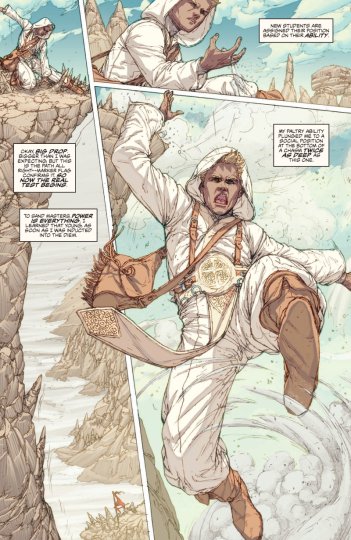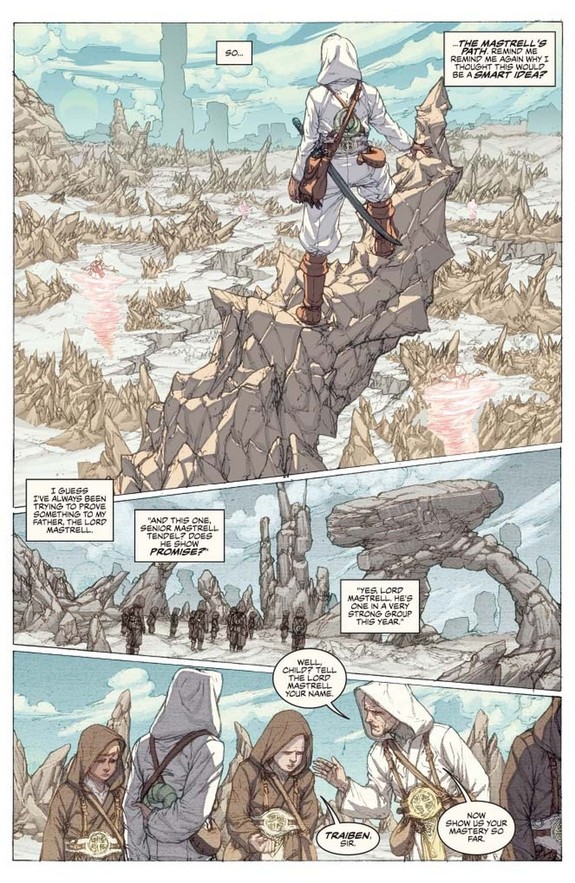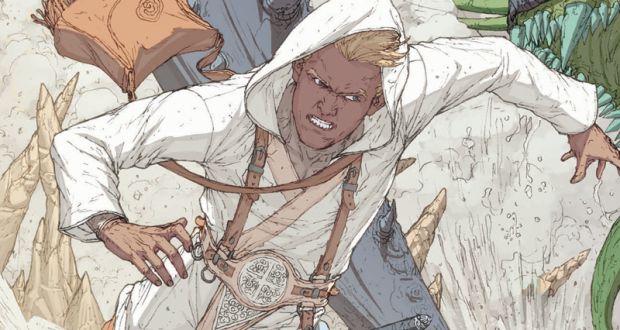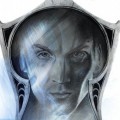Sanderson has been vocal about his prolific writing, often discussing the many novels he wrote before being published. The one story that he couldn’t seem to get out of his system formed his very first (still unpublished) novel. After finding great success, he went back to White Sand and tried again to write it as a prose novel. It still didn’t work for him. When the opportunity came to work on a graphic novel, he decided to give the story one more chance to find an audience.
If he felt the first two prose versions of this tale were not good enough to publish, I wonder how bad they were. This is not good. There are plenty of novel writers who can write graphic novels (Lauren Beukes!) and graphic novel writers who are also accomplished novelists (Warren Ellis!), but the majority of those that dip their toe in the medium they aren’t known for fall flat on their face (I love Bill Willingham and Fables but Peter & Max is woeful). Sanderson has now joined the lists of novel writers who should stick to what they know.
 I’m a big Sanderson fan. The Stormlight Archive is shaping up to be one of the best series I’ve ever read. But the biggest problem I have with him is that he is so inconsistent. Stormlight is so well written it is positively literary; Mistborn is solid YA; First Law is sloppy and tends to rely on easy gags; Reckoners is appalling. If indie comics publisher Dynamic Forces were hoping to hit the jackpot with a big name like Sanderson, they might be disappointed. It will still sell relatively well – his fans are loyal – but this is not a collection I’d recommend to anyone who isn’t a die-hard Sanderson and Cosmere fan.
I’m a big Sanderson fan. The Stormlight Archive is shaping up to be one of the best series I’ve ever read. But the biggest problem I have with him is that he is so inconsistent. Stormlight is so well written it is positively literary; Mistborn is solid YA; First Law is sloppy and tends to rely on easy gags; Reckoners is appalling. If indie comics publisher Dynamic Forces were hoping to hit the jackpot with a big name like Sanderson, they might be disappointed. It will still sell relatively well – his fans are loyal – but this is not a collection I’d recommend to anyone who isn’t a die-hard Sanderson and Cosmere fan.
White Sand features Sanderson’s trademark construction of an intricate and interesting magic system. It follows the story of Kenton, a late bloomer in the world of the Sand Masters, as he rails against his father for a place in the profession and finds himself thrust in a precarious position of authority. After all the Sand Masters of rank, bar Kenton, are massacred, he is rescued by a group of travellers from the other side of their world. When they eventually find their way to the city, Kenton must fight to save the Sand Masters as an institution while his travelling companions look for answers – answers only Kenton might know.
What I love about great graphic novels is the way the text and images complement each other. In this case, they don’t. The story is delivered primarily through Kenton’s internal monologue… and there’s just way too damn much of it. That’s including the fight scenes as well. Instead of making the choreography of the fight interesting, they simply add a lot of inner machinations of the character, with panel after panel of repetitive fighting. If the reader can’t work out the gist of it from the images, it doesn’t work as a comic. And the art itself is not good. The colours are drab, the panels uninteresting, and the characters incredibly stereotypical. There is nothing well crafted about this artwork. I picked up Preacher afterwards to cleanse my pallet and welcomed the varied panel-work.
 One of the most basic lessons writers learn is to not talk down to the reader. Readers are quite clever and can pick up on things that you might think are too subtle. Trust me. But just in case you weren’t clever enough to pick up on what is happening in the panel, the prose has you covered: ‘There is a playful irony to my best friends words, of course.’ Of course! If that ham-fisted, obvious-talk wasn’t bad enough, the exposition dumps are even worse. Kenton’s internal monologue has him ‘remember’ the most ridiculous information to helpfully explain the situation to the readers: ‘Of course, this sandling is Terken – it’s impervious to sand mastery’ and ‘Now I remember why Kerztians don’t venture onto deep sand! Because of these things – Sandlings.’ Well, how about that… he forgets major aspects of his own world and handily remembers them at the most opportune times for the reader!!!
One of the most basic lessons writers learn is to not talk down to the reader. Readers are quite clever and can pick up on things that you might think are too subtle. Trust me. But just in case you weren’t clever enough to pick up on what is happening in the panel, the prose has you covered: ‘There is a playful irony to my best friends words, of course.’ Of course! If that ham-fisted, obvious-talk wasn’t bad enough, the exposition dumps are even worse. Kenton’s internal monologue has him ‘remember’ the most ridiculous information to helpfully explain the situation to the readers: ‘Of course, this sandling is Terken – it’s impervious to sand mastery’ and ‘Now I remember why Kerztians don’t venture onto deep sand! Because of these things – Sandlings.’ Well, how about that… he forgets major aspects of his own world and handily remembers them at the most opportune times for the reader!!!
Disregarding the prose and art issues, looking instead at the story itself, I have further complaints (I know, you hoped I would have been done ripping this one apart…). The opening chapter focuses on Kenton and his struggle to win his father’s approval. This is interesting – the social strata, the everyman struggle of perseverance over natural talent, the complicated familial relationships. But this is quickly dropped in favour of a bigger conspiracy involving murder, massacres, and politics. Sure, those things can be interesting too, but it takes the issues out of Kenton’s hands and rapidly loses relevance for the characters. If they’d stuck with the struggles of an un-gifted young man trying to find his way, I might have forgiven some of the other issues plaguing volume 1 of White Sand.
Verdict: As bland and irritating as white sand on a blustery day.
White Sand is due to publish on June 21st.
* Thanks to Netgalley for providing a review copy in exchange for an honest review.
 Pop Verse Pop Culture Universe
Pop Verse Pop Culture Universe






